End of an illusion
Roughly half an hour later, we cross the Orange River into the Eastern Cape and Aliwal North, where we will spend the night. It is, however, still a little too early to check into our lodging, so we decide to try our hand at finding the old cemetery, for it is there that a recently “discovered” family member (more about that another time!), Great Great Aunt Minnie Florence Wesson née Bolton, ought to have been buried. Thanks to the eGGSA Photo Project, I have the coordinates on my laptop, so I boot it up and wake up the GPS at the same time (note to self: next time, have holiday & genealogy docs on Google Drive!). I punch in the latitude and longitude and Madam GPS (later christened Maggie by my father) thinks a little and then, in her clipped, efficient way, commands us to turn right. We obey. “Turn right,” she says again. And we obey, again.
Now it’s important to understand that we had, somehow, formed a rather naïve, romanticised impression of searching for the graves of family members. It seems almost laughable now, but, to an extent, I think we may have been picturing clearly defined plots separated by well-maintained pathways nestled in neatly manicured gardens. And so, with great anticipation, we are now eagerly straining for signs of Aunt Minnie’s resting place…
Madam GPS issues her next instruction, to turn left this time. Instantaneously, our illusion begins to crumble. There, ahead of us and to our right, sandwiched between the road we are on and the Orange River itself, lies the cemetery. A couple of tired gate posts hint at what must once have been an entrance. Above the rampant bushes and veld grass, a few of the taller gravestones are just visible. We slowly pull to a stop, processing the scene before us.
My super-brave mother is out the car first, and already plunging into the undergrowth. In a skirt and thin-soled flip-flops, I’m a little more tentative, but breathe a quick prayer and pick my way carefully toward some graves. There are no paths that I can see. Broken bottles, cans and litter lie strewn around. Many gravestones are broken; some seem to have been vandalised. The slabs on top of some graves have cracked open. I try hard not to look into the gaping darkness below, but images of coffins and skeletons are already clamouring for attention inside my head. I give myself a stern talking to and move on, taking care not to trip on any of the rubble that may send me sprawling toward one of those cavernous holes. While I have thought of cemetery recording projects as incredibly useful, I now understand their significance first-hand. I know this burial ground has not been fully photographed, so I whip out my camera and randomly snap a few headstones as I continue my search. Perhaps they will be of value to someone… Mum is valiantly forging through the brush, almost out of sight now, but it is evident that our random searching is highly unlikely to yield any results. We know Aunt Minnie died in 1911, so we start looking at the dates on the headstones – perhaps certain sections of the cemetery were used at certain times…
I suddenly notice some cardboard and flattened grass behind a grave, and, with a shock, realise someone has been sleeping here. Almost simultaneously, an awful smell hits me, and then I see why – a little way away, in front of another grave, buzzing flies and used toilet paper indicate that someone has been defecating in this place, too. I hurry away, gagging.
My mother is also returning from her search. Even the dates on the graves provide no real clues as to the organisation of the plots. Dejected, and more than a little horrified at the state of the cemetery, we realise that, without help, we have almost no chance of finding Aunt Minnie’s grave. So I haul out the laptop again and look up the address I have saved for the Aliwal North municipality.
Plan B
It’s not far, and we pull up outside the building a minute or so later. Mum and I go in, and the telephonist/receptionist person beckons to us, but seems to be on a phone call and helping someone seated across from him at the same time. He still needs to deal with a couple of people in front of us while juggling a steady stream of telephone calls. He does so efficiently and we are soon asking him whether there are cemetery records which could show us where our family member is buried. He tells us we need to speak to a Mr Wessels at Community Services, which is in a different building. He explains to us how we get there, and we step out into the sunlight again. We find the Community Services department without any hitches but, as we’re parking, a gentleman in a white bakkie is hurriedly pulling out of a parking space. He vanishes in puffs of reddish dust and Dad says, “I bet that’s Mr Wessels!” Sure enough, the lady behind the bars of reception confirms that “he has just left” and she doesn’t know when he’ll be back, but she takes our details and those of Aunt Minnie and says she will pass them onto Mr Wessels for us. We ask her what time they open and inform her that we’ll be back in the morning.
Of food and lodging
By now it is well beyond lunch time and also check-in time, so we drive back through the town, following the map I had printed to Conville Farm, where we will stay tonight. We find it just outside the town on a dirt road. The house is an old, rather imposing structure, designed by Sir Herbert Baker. We amble in through the open front door, but there’s nobody in sight and all is quiet. We take in the wooden floors, pressed ceilings and antique furniture, and then spot a bell on a table in the entrance hall. We ring it. Still nobody appears. After a few awkward minutes, we ring it again – louder – and listen. Ah – footsteps! They’re padding down a carpeted passage toward us. It turns out that they belong to Linda Gerrand, the lady of the house, who shows us to our rooms, each of which has a cute little French door opening onto a patio and semi-enclosed garden.
We unpack our overnight bags and the cooler box before enjoying a quick picnic lunch on the patio: leftover egg and bacon rolls, pork pies and cherry tomatoes. Then there’s time for a nap before getting ready for our evening meal. This we decide to take at the Riverside Lodge’s pub and grill, on the banks of the Orange River. Parking is limited and awkward, but the atmosphere is relaxed and the view in the evening sun is gorgeous. Dad settles on a serious steak – fillet with a cottage cheese and avo topping, Mum goes green with a salad and I choose a pizza. While waiting for our meal, we put a rough plan together for tomorrow and decide on our route to the “City of Saints”. As we look out over the river, we recount bits of our day, and give thanks, for our travels thus far have been safe, filled with family, fun and adventure…

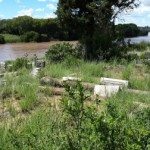

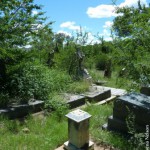


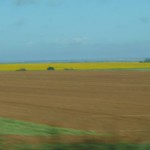
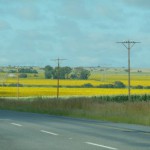
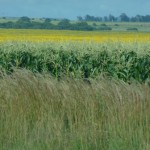





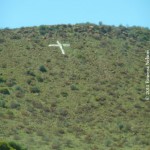

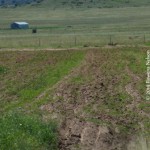




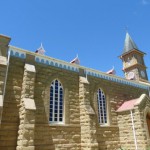
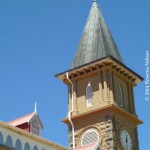





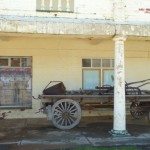
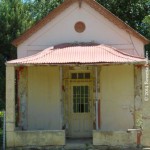



 Google and the Google logo are registered trademarks of Google Inc., used with permission.
Google and the Google logo are registered trademarks of Google Inc., used with permission.